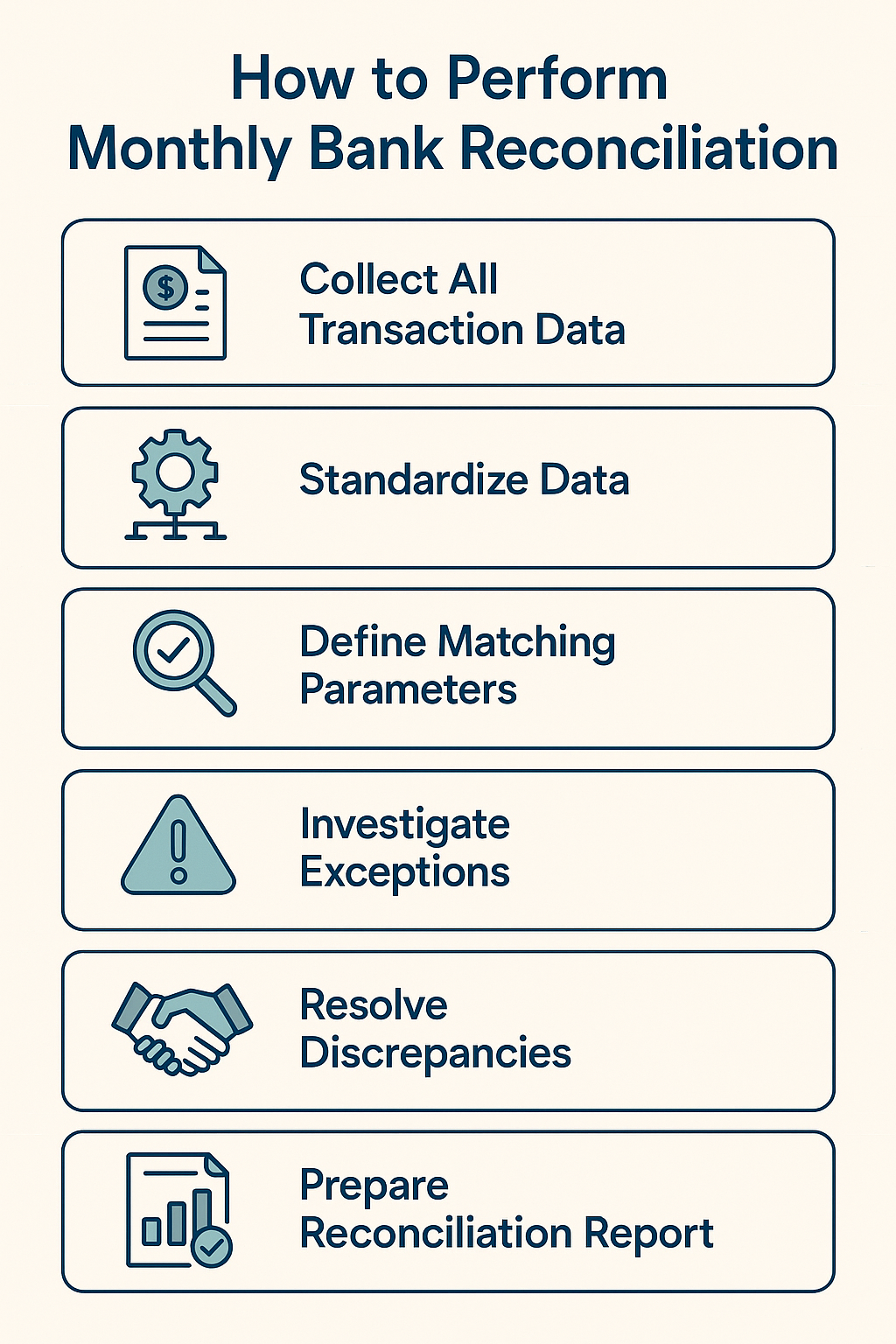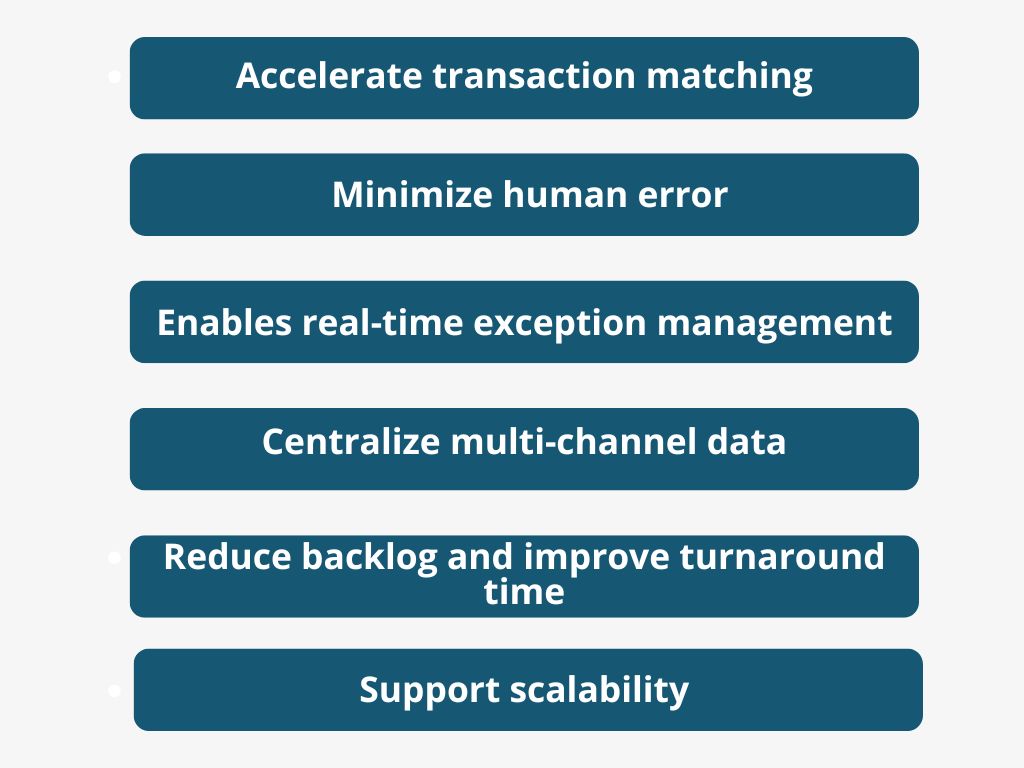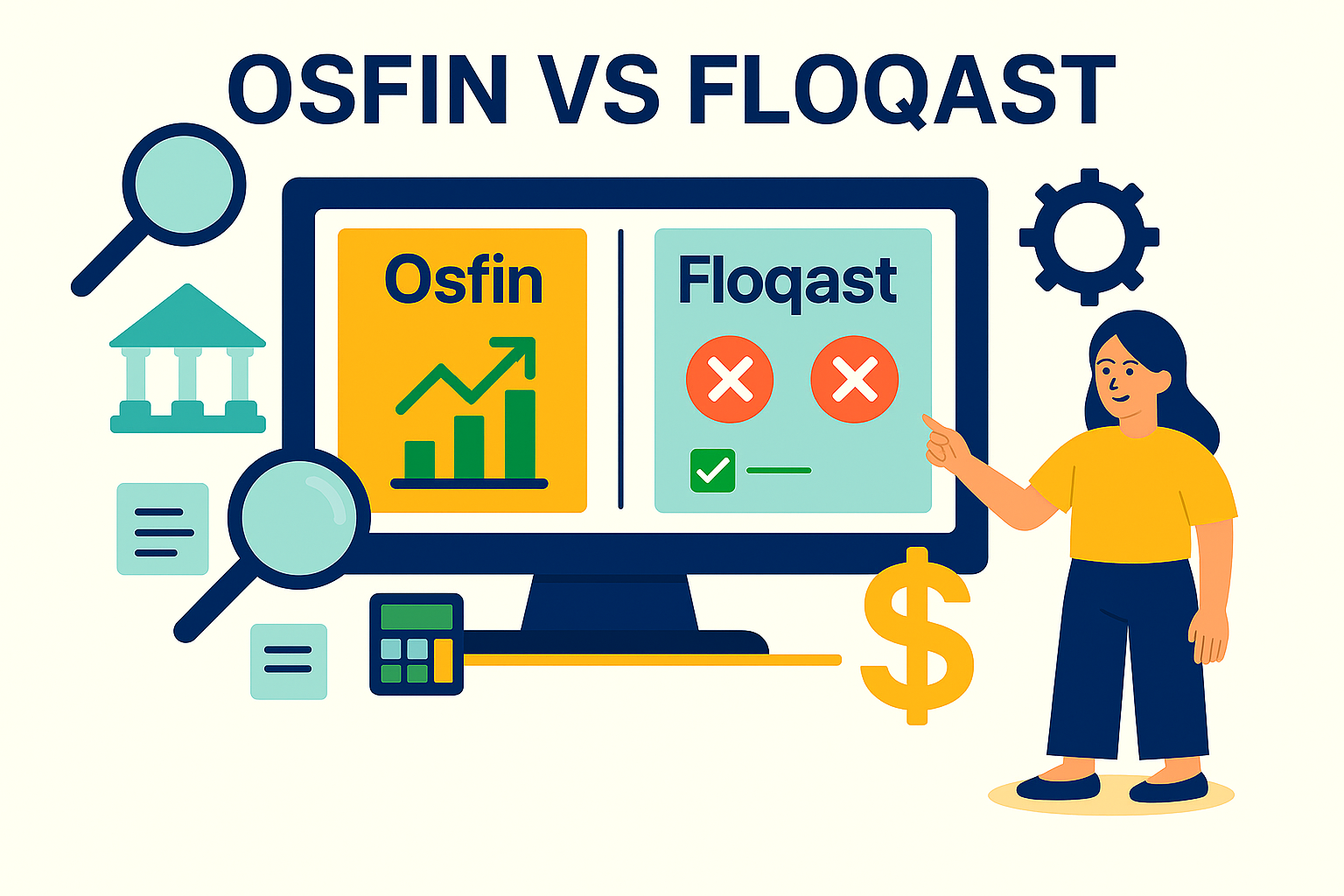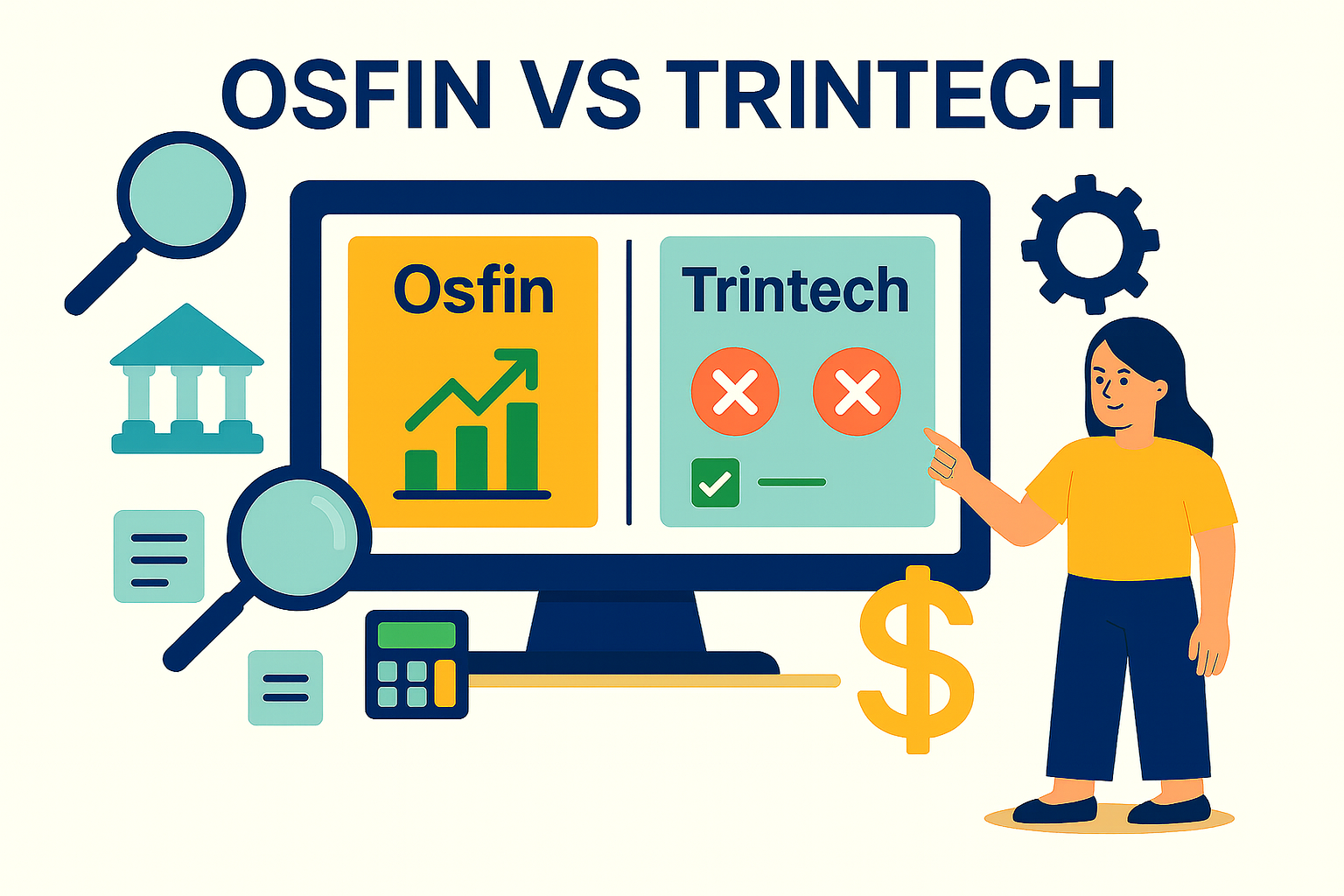Monthly Bank Reconciliation: Why Automating the Process Improves Accuracy and Speed
Bank reconciliation is a common and essential process that every financial institution has to perform. Each month, operations teams are tasked with validating that the institution's internal records match external sources. However, as transaction volumes grow, data sources multiply, and regulatory expectations tighten, what was once a manageable checklist item becomes highly complex.
Manual reconciliation methods, which are dependent on spreadsheets and siloed systems, introduce delays, errors, and blind spots. Even a single missed mismatch can lead to reporting inaccuracies, compliance red flags, or audit complications. But the good news is that you just need an automated reconciliation software to avoid such grim scenarios.
Reconciliation tools present a compelling case by enhancing accuracy, transparency, and compliance readiness of reconciliation processes. This is also evident by their rising demand as the reconciliation software market is expected to grow at a CAGR of 14.40% between 2025-2034.
In this article, we’ll explore the monthly bank reconciliation process and why automating the process is essential to achieve accuracy and speed.
What is Monthly Bank Reconciliation?
Monthly bank reconciliation is a process employed by financial institutions of comparing and verifying transactions at the end of every month from multiple sources, such as from CBS, ERPs, payment gateway providers, payment processors, POS systems, switch providers, ACH networks, and several other third-party financial networks against records in their Core Banking Systems and ledgers. The goal here is to make sure that the data from all these external sources matches with the internal transaction records of your financial institution.
As it’s evident, the process requires matching records from a wide range of data sources. Given the high volume of daily transactions financial institutions handle, manually matching these sources can not just lead to errors but also significantly reduce overall efficiency and productivity.
Why Monthly Bank Reconciliation Matters?
The end-of-month reconciliation process is considered quite significant for financial institutions as it helps on various fronts, including financial reporting, cash flow management, fraud detection, and, most importantly, ensuring a seamless experience for your customers. Here's why monthly bank reconciliation is essential for your institution:
1. Detects errors and fraud
Monthly bank reconciliation allows you to identify errors, omissions, or unauthorized transactions in either your internal records or external data sources. When these errors are detected early, you can rectify them accordingly, which also helps prevent fraud that might’ve gone unnoticed and ensures that all your records are accurate.
2. Improves cash flow management
Reconciled records give you a clear visibility of your available cash, pending settlements, or any liquidity gaps. This clarity further supports better fund allocation and treasury management.
3. Ensures accurate financial reporting
Regular reconciliation ensures that your financial statements reflect reality. With properly aligned internal and external records, you can confidently report balances, avoid misstatements, and maintain the integrity of your financial reports.
4. Enforces regulatory compliance
Banking regulators increasingly demand transparent and traceable financial records. A consistent reconciliation process supports internal audits and strengthens your institution’s audit readiness. Additionally, it reduces the risk of penalties or compliance issues with essential regulatory requirements under SOX, IFRS, BSA, or Basel norms.
5. Accelerates customer responsiveness
Accurate and accessible financial data empowers your customer support teams to respond swiftly to payment-related queries, refund requests, or billing disputes. It strengthens customer trust and reinforces your institution’s commitment to customer service.
Step-by-Step Process for Monthly Bank Reconciliation

This is how a typical end-of-month reconciliation is performed:
Step 1: Gather all transaction data
Collect records from all internal systems, such as your CBS, general ledger, sub-ledger, ERPs and external sources, including settlement files from payment processors, card networks, ACH network, Switch providers, etc.
Step 2: Standardize and preprocess the data
Most often, financial institutions receive files in distinct formats, such as, CSV, JSON, XML, MT940, etc. Ensure all data is in a consistent format. Cleanse, validate, and transform files to allow comparison across systems.
Step 3: Identify matching parameters
Define your reconciliation rules, such as matching by transaction ID, amount, timestamp, or reference number, based on the source and type of transaction.
Step 4: Investigate exceptions
Review unmatched transactions manually or with rule-based logic. Categorize exceptions based on timing differences, GL and fee mismatches, or reversals for deeper analysis.
Step 5: Resolve discrepancies
The next obvious step is to take corrective actions after investigating the discrepancies. This can include posting missing entries, correcting GL allocations, verifying reversals, or following up with third parties.
Step 6: Generate reconciliation report
The final step involves compiling the process in a comprehensive statement. This monthly bank reconciliation statement provides a detailed summary, including details of matched and unmatched transactions, exception trends, and resolution timelines. Along with providing a clear snapshot of your reconciliation process, this statement serves as an audit trail and comes in handy during internal reviews and audits.
Common Discrepancies and How to Resolve Them
Considering the vast amounts of records to be reconciled and the multiplicity of data sources, it’s quite inevitable for discrepancies to arise. However, not all discrepancies are the same. Financial institutions encounter a wide range of mismatch scenarios, each requiring different resolution strategies. Common types of discrepancies include:
1. Unposted or Delayed Transactions: Transactions processed by payment processors or third-party systems are often reflected with a delay or not posted to the CBS.
Resolution: Set up automated interfaces to ensure near real-time posting and reconcile settlement files daily to reduce mismatches.
2. Fee Mismatches: Variations between expected and actual fee debits by payment networks or processors. These errors can arise from incorrect fee structures or outdated rate schedules.
Resolution: Match fee schedules with system-generated reports and integrate rules-based engines to auto-validate charge applications.
3. Reversal Entries Not Logged Properly: Reversed or failed transactions not tagged correctly in the ledger, causing duplicate or open entries.
Resolution: Standardize transaction codes and tagging for reversals across all systems and run daily exception reports to flag inconsistencies.
4. Inter-Branch or Inter-Bank Settlement Mismatches: Internal transactions between branches or correspondent banks showing mismatched amounts or missing entries.
Resolution: Automate inter-branch entries and implement a centralized reconciliation dashboard to monitor variances.
5. Timing Differences: Settlements files from card networks or payment processors may appear late or on different accounting dates, causing temporary mismatches.
Resolution: Mark such entries as “timing exceptions” and auto-reclassify when settlement files are received.
6. Data Format or Field-Level Mismatches: Even if amounts match, differences in transaction references, dates, or narration fields prevent proper auto-matching. Along with this, different data sources can have different file formats, such as CSV, MT940, XML, or JSON.
Resolution: Use intelligent reconciliation engines that support fuzzy matching, field mapping, and exception flagging.
Best Practices for Efficient Monthly Bank Reconciliation
Some of the best practices financial institutions can adopt for their bank reconciliation include:
- Automate the reconciliation process: Use advanced reconciliation tools to match transactions across systems, reduce manual errors, and improve turnaround time.
- Reconcile more frequently: Don’t wait until the end of month. Instead, perform daily reconciliations, which help catch discrepancies early and reduce last-minute backlog.
- Define and enforce matching rules: Set clear and standardized system-wide rules for transaction matching (e.g., by amount, reference ID, date) to improve consistency and accuracy.
- Maintain clean and standardized data: Ensure data from multiple sources is clean, timely, and follows a uniform format.
- Strengthen exception management: Classify mismatches by type, such as timing, reversals, fee variance, and track resolution timelines closely.
- Ensure real-time integration with internal systems: Enable seamless data flow between reconciliation engines and internal systems to reduce lag and eliminate data duplication.
- Enable transparent audit trails: Maintain detailed logs of reconciled items, adjustments, and unresolved exceptions to support internal and regulatory audits.
- Continuously improve through analytics: Review exception trends, root causes, and reconciliation delays regularly to improve rules, processes, and your operation team’s training.
Role of Automation in Monthly Bank Reconciliation

The best solution to tackle the reconciliation of growing volumes of transactions that financial institutions have to process is to automate the whole process. Here’s how automation can streamline your monthly bank reconciliation:
1. Automation platforms integrate with various systems to reconcile all transactions in a unified dashboard.
2. Automated reconciliation eliminates the risk of data entry mistakes, miscalculations, and oversight, which are common in spreadsheet-based or manual processes.
3. With intelligent reconciliation engines, your operations team can flag mismatches in real time, enabling faster resolution.
4. Automation tools can process and match millions of transactions in minutes across diverse sources, much faster than manual processes.
5. Frequent automated reconciliations eliminate end-of-month pile-ups and ensure clean books throughout the reporting cycle.
6. As your transaction volumes grow, automation allows you to reconcile faster without adding additional staff, which enhances productivity.
Selecting the Right Bank Reconciliation Software
Here are the key factors to consider when selecting reconciliation platforms:
1. Integration Capabilities
Look for a tool that easily connects with your internal and external systems. Pre-built connectors save time and reduce IT dependency.
2. Automation and Intelligence
A modern solution should go beyond rule-based matching. Choose software with AI/ML capabilities that can auto-match transactions, learn from past exceptions, and optimize reconciliation logic over time.
3. Flexibility and Scalability
Your platform should handle high volumes of transactions, varied formats, and multi-source inputs without compromising performance. Make sure it can grow with your business needs.
4. Security and Compliance
Ensure the software adheres to enterprise-grade security standards, such as encrypted data transmission, role-based access, two-factor authentication, and audit trails.
5. No-Code Configuration
A no-code interface empowers operations teams to operate the system independently without waiting on IT for every rule update or change.
6. Exception Management Workflow
Exception handling should be built-in. Choose a solution that automatically flags, categorizes, and routes discrepancies to the right stakeholders for resolution.
7. Vendor Support and Onboarding
Beyond the tech, assess the vendor’s support features of the tool. Do they offer onboarding, data migration help, live support, and product training? These services are essential for smooth implementation and faster adoption.
Tip: Before making a decision, request a demo using your own data or reconciliation scenarios. This gives you a real-world view of speed, usability, and match accuracy.
{{banner1}}
ow AI-powered Tools Like Osfin Simplify Monthly Bank Reconciliation?
Now that you have a fairly good idea about what to look out for in an automated reconciliation tool, let’s take a closer look at how Osfin, an AI-powered reconciliation and financial operations platform, transforms monthly bank reconciliation from a manual, error-prone task into a streamlined intelligent workflow.
1. Seamless Data Integration
Osfin comes equipped with 170+ pre-built connectors that integrate effortlessly with CBS, ERPs, payment gateways, and other third-party platforms, allowing institutions to unify data from multiple sources without custom development.
2. Data Agnostic and Format-Friendly
No matter the file type, system, or format, Osfin can ingest and parse raw data into a clean, structured, reconciliation-ready form. This agnostic architecture ensures compatibility across legacy and modern systems alike.
3. High-Speed Reconciliation
Osfin delivers at enterprise scale: 30 million records reconciled in just 15 minutes, with zero compromise on 100% accuracy. With Osfin, speed meets precision, enabling faster month-end closes.
4. Automated Tagging of Unmatched Transactions
Osfin enhances visibility into unreconciled payments by automatically tagging unmatched transactions, helping teams pinpoint exceptions immediately and reduce turnaround time.
5. Smart Exception Handling
With a built-in exception handling engine, Osfin identifies the root cause of mismatches and automatically loops in internal or external stakeholders to ensure faster resolution workflows.
6. User-Friendly Platform
Designed for finance professionals, Osfin’s no-code interface eliminates the need for IT dependency. You can map data, configure workflows, and monitor reconciliations using an intuitive environment.
7. Real-Time Visibility
The platform’s centralized dashboard offers a real-time, end-to-end view of the entire reconciliation process, providing everything from transaction-level details to high-level summary metrics, all in one place.
8. Enterprise-Grade Security
Osfin uses 256-bit SSL encryption, role-based access controls, two-factor authentication, and undergoes regular VAPT testing to ensure your financial data is secure at every level.
9. Expert Support
With Osfin, you can easily consult with a dedicated team of experts to support onboarding, system integration, exception handling, or compliance queries, ensuring you're never on your own.
{{banner3.1}}
FAQs on Monthly Bank Reconciliation
1. What is an example of a monthly bank statement?
A common monthly bank statement example would include a detailed summary of all account activity over a specific month. This typically includes opening and closing balances, transaction history, deposits, withdrawals, fees, and interest earned during a month.
2. Is bank reconciliation done monthly?
Yes, bank reconciliation is commonly done monthly. However, for financial institutions, daily reconciliation is very much recommended to ensure accuracy, detect discrepancies early, and maintain operational control.
3. How does automation improve the speed of bank reconciliation?
Automation eliminates manual matching by using intelligent rule engines to process and reconcile transactions in bulk, reducing reconciliation time from days to minutes, even at high volumes.
4. Can automated reconciliation handle complex, multi-source financial data?
Yes. Tools like Osfin are designed to ingest data from multiple sources, such as CBS, ERPs, payment gateways, card networks, or switch providers, and reconcile across different formats using advanced AI/ML models.


